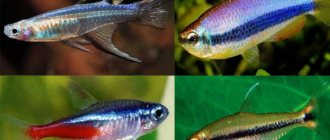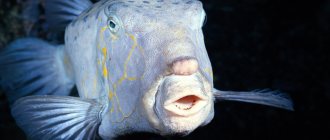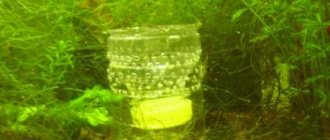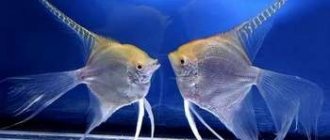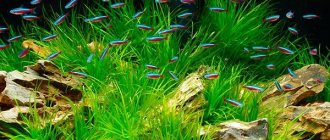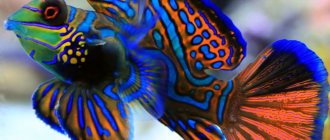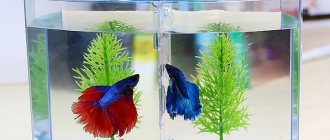3.9
(7)
In the aquarium industry, there is a special circle of cichlid lovers. These aquarists keep these fish exclusively, provide them with the best living conditions and develop a biotope design for the “jar”. Not surprising, because these animals really stand out and are quite unusual. They have interesting habits and have a beautiful appearance. For example, one of the most prominent representatives of cichlids is Geophagus.
There are many of its species, which differ in size, color, spawning process and other features. But each variety is beautiful and interesting in its own way.
Description
The natural habitat of these creatures is South America. Moreover, they inhabit a wide variety of water bodies. These include fast-flowing rivers and areas with standing water. Some varieties like clear water, others like it when it is almost black, tinted by fallen leaves and branches. In addition, some individuals are heat-loving, while others, on the contrary, prefer cold. Most species grow no more than 30 cm. On average it is 10-12 cm. In aquariums, naturally, somewhat less.
The name "geophagus" is translated from Greek as "earth eater". This “name” fully corresponds to the behavior of these fish. They love to rummage in the ground. When they look for food, they take stones into their mouths and throw them out through their gills, leaving only what they can eat in their mouths.
In general, Geophagus is not a specific type of fish, but a large genus that includes a lot of subspecies that differ in shape, color, etc. Their common feature is a slightly conical head and high-set eyes. The body is flattened laterally and, as a rule, has various stripes.
Natural habitat
In nature, geophagus are found in the waters of South America. Representatives of this species feel absolutely comfortable both in standing water and rivers with strong currents. In addition, they are completely unpretentious to temperature - they can feel comfortable in both cold and warm water.
In their natural habitat, geophaguses are undemanding to water quality: they can be found in perfectly clean, transparent reservoirs, and fish will also not experience discomfort in dark, almost black waters.
Content
These fish are not too whimsical, but they are still more suitable for experienced aquarists, since they need to be provided with certain conditions for a comfortable life. Actually, the contents of geophagus include:
Aquarium . It is important that it is spacious enough given the size of these pets. Most species grow up to 12 cm, but some species are twice that size. Therefore, it is advisable to purchase a capacity of about 300 liters. This will allow you to have a small flock that will be comfortable swimming, have a place to hide, etc.;
Water parameters . Hardness is secondary and can vary from 6 to 18 dGH, but it is better to keep it higher. Acidity – 6.5-7.5 pH. Temperature is about 24-27 degrees. It is also important that the water is clean. In nature, most species are accustomed to its transparency. In addition, these fish love to rummage in the soil, and it is necessary that there are no deposits of organic matter in it, otherwise the water in the aquarium will be constantly cloudy. Accordingly, it is necessary to ensure regular replacements with high-quality cleaning of the substrate;
Equipment . It needs to be given special attention because, again, the water in the aquarium must be clean. At the same time, the cichlids themselves create a strong biological load. Therefore, a standard internal model with a sponge cannot be used here. The external type is best because it has good performance and can be equipped with a variety of fillers, depending on the aquarist's preferences. Alternatively, you can make your own phyto or biological filter. Both options are quite reliable, but the main thing is to take into account all the nuances so that such cleaning works;
Lighting and decorations . Geophagus itself prefers shade. It looks great in a biotope aquarium, stylized as water bodies of South America. Therefore, you can use large stones, snags, roots and even fallen leaves, which will slightly tint the water and oxidize it, which will also have a positive effect on the well-being of your pets;
Plants . As a rule, aquarists are unable to successfully grow any flora with these cichlids. The only options are large bushes in pots (e.g. Echinodorus, Nymphea, Cryptocorynes) or something with tough leaves like Anubias.
It is worth mentioning separately about the diet of these animals. Under natural conditions, it completely depends on the body of water in which the fish lives. Mostly these cichlids feed on small insects, as well as fruits that have fallen from trees, aquatic larvae, etc. In an aquarium, in order for them to feel good, they need to be provided with a sufficient amount of chitin and fiber, otherwise problems with the gastrointestinal tract may arise.
The menu should include live and frozen food such as tubifex, bloodworms, and brine shrimp. You also need to add vegetation. For example, cucumbers, zucchini, spinach, lettuce. Special dry food from manufacturers is also perfect. These fish eat well the pellets intended for Malawian cichlids.
Feeding
Aquarium fish are not picky when it comes to food. Willingly consumes live and dry food. The daily diet should be varied, with the obligatory inclusion of plant foods. You can give cereals, leafy greens scalded with boiling water, shellfish meat, and boiled vegetables.
The fish should not be allowed to get fat. Feeding is carried out 3 or 4 times a day, the portions are small.
It is interesting to note that geophagus do not rise to take food, but wait for it to fall to the bottom. Then they pick it up from the ground.
Compatibility
The optimal neighbors for geophaguses are their natural neighbors. That is, these are fish that also live in the rivers of South America. For example, these are other cichlids (angelfish, severum), catfish like corydoras and tarakatums.
African relatives living, for example, in Lake Malawi are not suitable for these fish. You should also avoid proximity to small species such as neons, guppies, cardinals, rasboras, as they will only become feeding. Well, of course, goldfish are not suitable, since they will regularly bite their tails and be threatened, which will inevitably lead to the death of the famous relatives of the silver crucian carp.
Geophagus redhead
The homeland of these unpretentious and easy-to-breed fish is considered to be South America, Brazil, the Amazon River basin and the Tapajos River. In the USA and Western Europe they were introduced as a popular novelty in 2004, and appeared in Russia only in 2006.
Appearance
The body of red-headed geophagus is high, elongated and laterally flattened. Its length does not exceed 25 cm.
The color of the body is pale silver or golden-olive, depending on the conditions of detention. Across it you can discern pale stripes of a dark olive color, and in the center there is a large black almost round spot. The edges of the scales have a turquoise tint. The iris of the eyes is golden-red and the lips are blue.
The fins on the back, belly and tail are decorated with alternating red and blue stripes. Unpaired fins have braids.
A distinctive feature of these fish is their red head and forehead.
Red-headed geophagus.
Compatibility and containment conditions
Red-headed geophagus are kept in schools of 6-12 fish or in harems. Confrontations sometimes occur within the pack. Males stand face to face and make sharp counter movements, but it rarely comes to a fight. Uara, severum, angelfish, corydoras, and other peaceful cichlids are considered suitable neighbors for earth-eaters.
The aquarium for such a flock should be at least 250-350 liters. These fish can also be kept in a general aquarium, but then its volume should be larger. The permissible water temperature is 26-30°C, and the optimal one is 27.5-28ºC.
The water should be soft or medium hard, and the acidity should be between 6-7. It needs to be regularly aerated, filtered and replaced daily by 20-30 percent. It is better to put river sand at the bottom. Often it is not necessary to siphon it.
Vegetation. Suitable plants include Echinodorus, Cryptocoryne, Anubias, Sagittaria, Vallisneria, etc.
Aquadesign. You can decorate your home pond with rounded stones, driftwood, and old flower pots, which will also serve as shelters.
Dimmed light is recommended. Plants floating on the surface of the water won't hurt either.
Feeding. Red-headed geophaguses are omnivorous: they readily eat both plant and animal food. They prefer to feed from the ground. They can be given drowning live, frozen and dry food, minced shrimp and mussels, boiled pumpkin and salad. The main requirement is a variety of foods with a predominance of plant foods. Doing this reduces the risk of hexamitosis (a very common disease among these fish).
Breeding
Individuals mature by one year. By this point, they are already independently forming a pair of those fish with whom they found themselves in the same school from an early age. It will not be possible to create a pair artificially, since these animals have a stubborn character and will only conflict with new neighbors. It is not difficult to identify an individual by gender. By this period, males acquire brighter colors and their behavior changes. They begin to inflate their gills and fluff out their fins, while performing mating dances.
Stimulation of spawning is carried out through increased feeding and increasing the temperature to 28-30°C. In addition, it is necessary to increase the frequency of substitutions, about 20% of the total volume.
After this, you need to wait until the couple finds a place for themselves, digs a hole in the ground and guards it. At the same time, the caviar rushes to the nearest decorative element. At one time, the female lays 150-200, during subsequent spawnings - twice as much. The male fertilizes the eggs in several stages, and during this entire period both parents carefully ensure that no one swims up to their nest.
Every other day, the parents collect eggs with their mouths and carry them for about 10-14 days. After this period, they release fry that are completely ready for life, which themselves swim and feed. Parents can only help them slightly in finding food.
For some time, the fry stay close to their parents, and if danger arises, they hide in their mouth. But, despite such care, other individuals can still eat the young. Therefore, many aquarists simply remove the eggs from the parents' mouths and incubate them in a separate container. Starter food: Artemia nauplii.
Diet
When preparing for spawning, diet is of great importance. Thus, live bloodworms and daphnia stimulate Steindachner's geophagus to reproduce, so during this period this food should be given more often.
The rest of the time, live food can be replaced with frozen meat food such as chopped shrimp, mussels, and earthworms. It is recommended to add plant-based food to the diet.
It is very important that the spawners eat well during the pre-spawning period, since after the female takes the eggs into her mouth, she will not eat for about two weeks.
Kinds
As mentioned above, these fish are presented in a wide variety, and they differ significantly from each other in terms of keeping conditions and external features. The most popular types are:
Geophagus red-headed (tapajos) or earth-eater
It got its name because of the red spot that appears on the head of males. The color itself can change depending on the mood, conditions of detention, environment, etc. Grows up to 18 cm;
Surinamese
This species is characterized by a small black spot in the center of the body, as well as a golden color, bluish spots or stripes on the side. Males have elongated rays on the tail;
Winemiller
This golden fish is one of the largest representatives of its species. Reaches a length of 20 cm. Loves soft water no more than 8 dGH. It has a dark spot on the body, like the Surinamese species, as well as a lot of light stripes. For their well-being, it is important that the water contains tannins released from driftwood and leaves;
Steindachner
Grows up to 10-15 cm. The body is olive or grayish. During the spawning period, olive-colored stripes are strongly visible. The tail and other fins have a red edge and yellowish spots. Males have a fatty bump on their forehead, which turns red during spawning. In a flock it is important that there are more males. This species also likes soft water;
Altifrons
A large representative of its species. In an aquarium, individuals grow up to 20-25 cm. They are distinguished by a rather bright color. The main part of the body is olive with brown spots and a turquoise tint. The fins stand out due to their pink hue with pearly-gray splashes. They carefully monitor their territory; the water should be hard. Shelters are required;
Brazilian view
It is also a very large fish, which under good conditions can reach sizes of 30 cm. It has a gray-green or gray-yellow color with pearl dots. Males are larger and also have a bump on their forehead. During spawning, a black dot and a dark stripe along the eyes appear on the body. Brazilian Geophagus are kept in species aquariums because they are quite aggressive;
Heckel or Satanoperka
They grow up to 14-17 cm. They are characterized by a silver-beige color with horizontal stripes. The main difference is the sharp muzzle and the presence of three dark spots on the side. Geophagus Heckel has a peaceful nature, lives in flocks of 5-8 individuals;
Balzani
The maximum size is 20 cm. It is amazingly calm, except during the spawning period. Has a large head with a massive forehead. There is a black spot and thin vertical dark stripes on the side. The body itself is gray-yellow;
Diseases and prevention
The immunity of geophaguses is strong. How long representatives of the species live depends on feeding and living conditions. Life expectancy is several years.
Tapajos get sick only if the living conditions are not acceptable. Diseases characteristic of cichlids occur. The sick individual is immediately separated from the healthy ones.
The most common reason for decreased immunity and death of pets is poor water quality, high content of nitrates and ammonia. For prevention, it is necessary to maintain proper filtration and aeration, and do not forget about periodic water changes.
If proper water quality is maintained, geophaguses live a long time, delighting with their beauty and original appearance.
